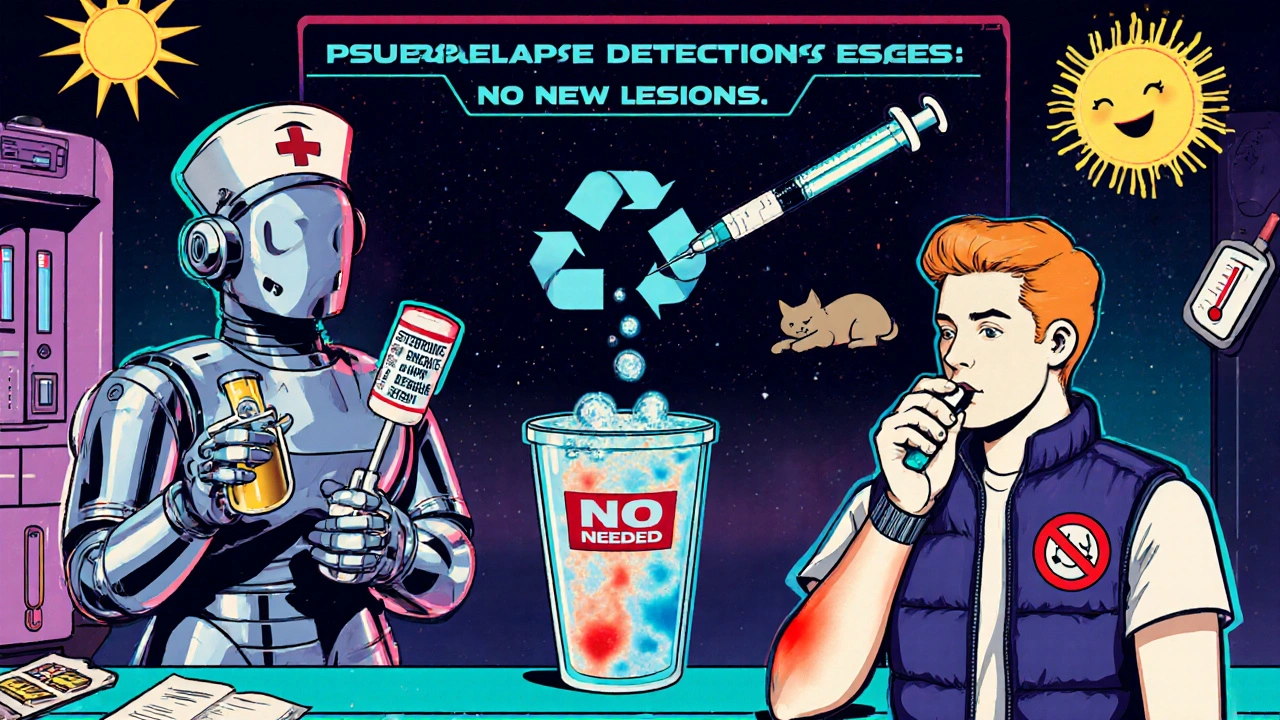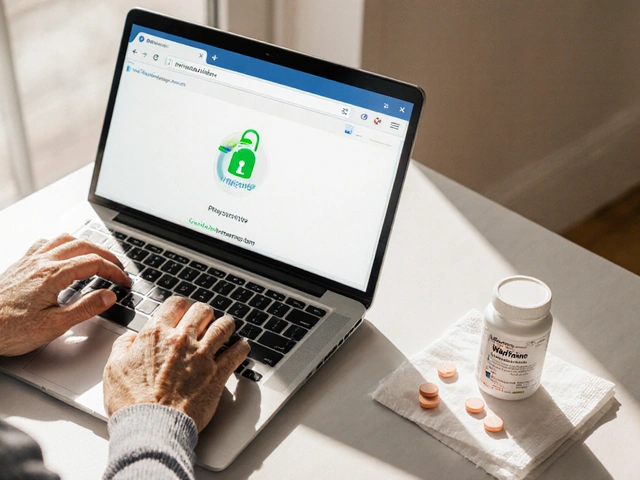When your MS symptoms suddenly get worse, it’s natural to panic. Is this a real relapse? Or is it something else - something temporary, something you can fix without drugs? The truth is, not every spike in symptoms means your MS is actively attacking your nervous system. Many people with MS experience what’s called a pseudorelapse - a flare-up that looks like a relapse but isn’t. And mistaking one for the other can lead to unnecessary treatments, side effects, and even hospital stays.
What’s the real difference between a relapse and a pseudorelapse?
A true MS relapse happens when new inflammation damages myelin in your brain or spinal cord. This isn’t just a bad day - it’s a new lesion forming. Symptoms last at least 24 to 48 hours, often longer, and show up without any obvious cause like fever or heat. You might suddenly lose balance, have trouble walking, or notice new numbness. An MRI during a true relapse will usually show new or active lesions. A pseudorelapse, on the other hand, is your body reacting to stress. No new damage. No new inflammation. Just your already weakened nerves getting overwhelmed. Think of it like an old electrical wire that starts sputtering when it gets too hot or tired. The wire’s still broken - but the problem isn’t getting worse. It’s just struggling more under pressure.What triggers a pseudorelapse?
Pseudorelapses are triggered by things that raise your body temperature or stress your system. The most common ones:- Urinary tract infections (UTIs) - the #1 trigger. Up to 67% of pseudorelapses are linked to them. Even a mild UTI you didn’t notice can make your legs feel heavier or your bladder worse.
- Heat - hot showers, summer weather, saunas, even wearing a heavy coat. About 41% of people with MS report heat as a trigger. Uhthoff’s phenomenon - where vision blurs or dims with heat - affects 60-80% of those who’ve had optic neuritis.
- Fever - any infection that raises your temperature above 37.8°C (100°F) can trigger symptoms. A cold or flu might make your fatigue skyrocket or your coordination slip.
- Stress and exhaustion - emotional stress, lack of sleep, or overdoing it physically can make symptoms feel worse. Your nervous system is already working hard just to keep things running. Add stress, and it falters.
Here’s the kicker: pseudorelapses often fade fast - within hours or a day - once the trigger is removed. Cool down, treat the infection, rest. And your symptoms? They go back to baseline. No permanent damage.
Why steroids don’t help with pseudorelapses
High-dose IV steroids like methylprednisolone are the go-to treatment for true relapses. They work by calming inflammation. But if there’s no inflammation - if your nerves are just overheated or tired - steroids do nothing. They won’t fix the problem. And they come with risks. Studies show that 30-40% of pseudorelapses are wrongly treated with steroids. That’s not just a waste of time - it’s dangerous. Side effects include:- High blood sugar (25% of patients)
- Insomnia (40%)
- Mood swings or even steroid-induced psychosis (rare but real)
- Increased risk of infections
One nurse with MS on Reddit shared how five patients she saw got unnecessary steroids for UTI-triggered pseudorelapses. One ended up in the hospital with steroid psychosis. That’s preventable.
True relapses? Steroids can help shorten them. About 70-80% of people see faster recovery with steroids. But only 45-55% fully recover. That’s why you need to be sure it’s a true relapse before you start.

How doctors tell the difference
There’s no single test. Diagnosis comes from a mix of history, physical exam, and a few simple checks:- Duration - Did symptoms last more than 24 hours? If it’s gone in 6 hours, it’s likely a pseudorelapse.
- Triggers - Did you have a fever? A UTI? Were you outside in 30°C weather? Did you skip sleep for two nights? These are red flags for pseudorelapse.
- Testing - A urine test for infection, a temperature check, and a basic blood panel (to check sodium and glucose) are quick, cheap, and often enough.
- Imaging - If it’s still unclear, an MRI can show if there are new lesions. No new lesions? Likely a pseudorelapse.
Neurologists who specialize in MS get it right 85% of the time. General neurologists? About 60%. Primary care doctors? Only 45%. That’s why it’s so important to see an MS specialist when symptoms change.
What you can do - at home and with your doctor
You don’t have to wait for an appointment to figure out what’s going on. Here’s what works:- Keep a symptom diary - Note when symptoms start, how bad they are, what you were doing, your temperature, and if you had any signs of infection. This helps your doctor spot patterns.
- Check your temperature - If you’re running a fever, treat the infection first. Antibiotics for a UTI? Symptoms often improve within 24 hours.
- Use cooling tools - Cooling vests, cold drinks, fans, air conditioning. If heat is your trigger, lowering your core temperature can make symptoms vanish in hours.
- Use the MS-RAT tool - A new 2023 assessment tool (MS Relapse Assessment Tool) uses symptom duration, temperature, and functional impact to give a probability score. It’s 92% accurate at telling true relapses from pseudorelapses.
One patient, MSWarrior2020, said her leg weakness during a heatwave vanished in two hours after she put on a cooling vest. No meds. No ER. Just smart management.

Why this matters for long-term health
True relapses can lead to permanent disability. Each one leaves behind damage. Pseudorelapses? They don’t. They’re temporary setbacks, not progress markers. But here’s something many don’t talk about: if you’re older, have advanced MS, and have a pseudorelapse, you might not bounce back as fast. Your body has less reserve. A week of bed rest after a heat-triggered flare might leave you weaker, even if the nerves recover. That’s not damage from MS - it’s deconditioning. And it’s just as real.Studies show about 15% of people over 55 don’t fully return to their baseline function after a pseudorelapse - not because of new lesions, but because they lost strength during the episode. That’s why staying active, even during flares, matters.
What’s new in 2025
Telemedicine tools are getting better. Apps like MS Selfie let you record symptoms and send videos to your neurologist. Early results show 78% accuracy in distinguishing relapses from pseudorelapses. Researchers are also looking at blood tests. Neurofilament light chain - a protein released when nerves are damaged - is higher in true relapses. If this test becomes routine, we might soon have a simple blood draw to confirm whether inflammation is happening.The bottom line? Not every flare is a relapse. And not every relapse needs steroids.
Ask yourself: Did something change in my body or environment? Is the symptom new, or just worse? Did it come on fast and fade fast? If yes - treat the trigger, not the symptom.
When in doubt, check for fever, get a urine test, cool down, rest. Then call your neurologist. Don’t rush into steroids unless you’re sure.
Knowing the difference doesn’t just save you from side effects - it saves your body from unnecessary stress. And in MS, every bit of energy you conserve matters.
Can a pseudorelapse turn into a true relapse?
No. A pseudorelapse is not a precursor to a true relapse. It’s a separate phenomenon. However, if you have a UTI or fever and your symptoms don’t improve after treating the trigger, that could mean a true relapse is happening at the same time. Always follow up with your doctor if symptoms persist beyond 48 hours after removing the trigger.
Do I need an MRI every time I have a flare?
No. Most pseudorelapses are diagnosed based on history and simple tests like urine analysis and temperature checks. MRI is only needed if symptoms are severe, new, or don’t improve after removing triggers. Overuse of MRI can lead to unnecessary anxiety and costs.
Is it safe to take steroids if I’m not sure it’s a relapse?
It’s not recommended. Steroids have real risks - high blood sugar, mood changes, sleep problems, and increased infection risk. If there’s no inflammation, steroids won’t help and might harm you. Always rule out triggers first. If your doctor pushes steroids without checking for fever, infection, or heat exposure, ask for a second opinion.
Why do some doctors still give steroids for pseudorelapses?
Many doctors aren’t trained specifically in MS. In busy clinics, it’s easier to prescribe steroids than to investigate triggers. Also, some patients feel better after steroids - but that’s often because the trigger (like a UTI) was already being treated at the same time. The steroid gets credit for the improvement, even if it had nothing to do with it.
Can stress alone cause a pseudorelapse?
Yes. Severe emotional stress can raise cortisol and body temperature slightly, which may worsen symptoms in people with damaged nerves. It doesn’t cause new MS damage, but it can make existing symptoms feel much worse. Managing stress through rest, therapy, or mindfulness can help prevent these episodes.
Should I avoid heat entirely if I have MS?
You don’t need to avoid heat completely - just be aware of it. Many people with MS enjoy swimming, hot tubs, or summer outings. The key is to cool down quickly if symptoms start. Use cooling gear, stay hydrated, and avoid prolonged exposure. You can still live fully - just with smart adjustments.
What’s the best way to track my triggers?
Use a simple notebook or phone app. Record: date, symptoms, duration, temperature, recent infections, sleep, stress levels, and any new activities. Look for patterns over weeks. Many people find they have flare-ups after certain foods, lack of sleep, or weather changes. Tracking helps you predict and prevent.
What to do next
If you’ve had a recent flare-up:- Check your temperature - if it’s above 37.8°C, treat the cause.
- Get a urine test - even if you don’t feel like you have a UTI.
- Stay cool - use fans, cold towels, cooling vests.
- Rest - don’t push through fatigue.
- Wait 24-48 hours - if symptoms don’t improve, contact your neurologist.
Don’t assume every bad day is a relapse. Sometimes, your body is just asking for a break. Listen to it - and don’t rush to the steroid drip unless you’re sure.






Kimberley Chronicle
November 24, 2025 AT 15:21Really appreciate this breakdown-especially the MS-RAT tool mention. As a neurology NP, I’ve seen too many patients get slammed with IV steroids for UTI-induced pseudorelapses. The key is always rule out infection first, then heat, then sleep deprivation. No MRI needed unless symptoms persist beyond 48h post-trigger removal. The 92% accuracy stat is game-changing for outpatient management.
Also, neurofilament light chain assays are coming online in major centers-expect them to become routine in 12–18 months. We’re moving toward biomarker-driven relapse diagnosis, not just clinical guesswork.
And yes-cooling vests are underrated. I’ve had patients report 70% symptom reduction within 90 minutes of use. No pharmacology required.
fiona collins
November 25, 2025 AT 03:43Always check for UTIs first. Always.
Heat? Cool down.
Stress? Rest.
Still bad after 48 hours? Call your neurologist.
Don’t rush to steroids.
Simple.
Effective.
Life-saving.
Amy Hutchinson
November 25, 2025 AT 11:11OMG I had this exact thing last summer!! Thought I was having a full relapse, cried for an hour, called my neuro, then realized I’d been running a 100.4 fever from a UTI I didn’t even know I had. Got antibiotics, chilled out with ice packs, and poof-my legs worked again in 14 hours. Steroids would’ve been a waste and I’d’ve been stuck with insomnia and sugar crashes. Thanks for validating what I felt was just ‘bad luck’-turns out it’s just MS being a diva.
Also, cooling vest? Bought one on Amazon. Best $120 I ever spent. No joke.
Archana Jha
November 26, 2025 AT 20:08Wait… so you’re telling me Big Pharma doesn’t want us to know this? Why? Because steroids make money. Why do they even exist if they don’t work for 40% of flares? Because they’re profit engines. The FDA? Complicit. Neurologists? Brainwashed by pharma reps. They don’t care about your nerves-they care about your insurance code. This is why so many of us end up on 5+ meds and still feel like garbage. The truth? Your body doesn’t need chemicals-it needs rest, water, and to stop being roasted by the sun. But no one wants to sell that.
Also, did you know 5G towers make your symptoms worse? Not proven? Of course not. They don’t want you to know. Look up ‘neuroinflammation and EMF’-it’s all connected. The ‘heat’ thing? Just a cover-up. Your nerves are being fried by invisible waves. Stay off Wi-Fi. Use wired ethernet. And pray.
Aki Jones
November 26, 2025 AT 23:10Let’s be real: the ‘pseudorelapse’ concept is a dangerous myth perpetuated by neurologists who don’t want to admit their diagnostic limitations. If your symptoms worsen, you have MS-you’re having a relapse. Period. The ‘trigger’ narrative is just a way to avoid admitting that disease-modifying therapies are failing. And yes, steroids have side effects-but so does untreated neuroinflammation. You’re trading short-term discomfort for long-term disability. The 30–40% misdiagnosis rate? That’s not a flaw in the system-it’s a failure of clinical rigor. If you’re not getting an MRI every single time, you’re gambling with your future. And the ‘MS-RAT tool’? A toy. It’s not peer-reviewed in a major journal. Don’t trust algorithms over neurology. Trust MRI. Always.
Also, your ‘cooling vest’ won’t stop axonal degeneration. Only high-efficacy DMTs will. And if you’re not on ocrelizumab or cladribine, you’re already behind.
Dolapo Eniola
November 27, 2025 AT 18:12Bro, this is why Africa doesn’t have MS problems-no AC, no heatwaves, no stress culture. We just live. You people overthink everything. UTI? Drink more water. Heat? Sit in shade. Stress? Pray. Steroids? Nah. We don’t need your Western drugs to survive. My cousin with MS walks 10km daily in Lagos heat-no vest, no meds, no panic. You think your nerves are weak? Mine are forged in 38°C sun and 3am power outages. You need resilience, not a cooling jacket.
Also, why is everyone so scared of steroids? We use them for malaria here-no big deal. You’re weak. That’s your problem.
🔥🔥🔥
Josh Zubkoff
November 28, 2025 AT 12:19Okay, but let’s talk about the emotional toll of this. I’ve had three ‘pseudorelapses’ in two years. Each time, I thought I was failing. Each time, I cried in the shower because I felt like my body was betraying me. And then-poof-it’s gone. No one sees that. No one talks about how terrifying it is to have your body lie to you. You think you’re regressing, then you’re told ‘it’s just heat.’ But what if it’s not? What if next time it’s real? And what if I waited too long because I trusted the ‘pseudorelapse’ myth? The anxiety is worse than the symptoms. And no one ever talks about that. The article gives you facts-but it doesn’t give you permission to grieve the loss of certainty. That’s the real relapse.
Also, I hate that we have to become detectives just to get basic care. Why isn’t there a simple blood test? Why do I have to beg for a urine dip? Why does my neurologist look at me like I’m wasting his time when I say ‘I think it’s a pseudorelapse’? It’s exhausting. And the system is designed to make us feel crazy. I’m not crazy. I’m just tired. And I’m tired of proving I’m not faking.
giselle kate
November 29, 2025 AT 16:36This is exactly what happens when you let corporate medicine dictate neurology. Steroids are a Band-Aid for a broken system. The real issue? MS is being treated like a mechanical problem when it’s a systemic immune catastrophe. And ‘pseudorelapse’? That’s just a euphemism for ‘we don’t know what’s happening.’ The truth? Your nervous system is in chronic siege. Heat? Stress? UTIs? They’re just the spark. The fuel is already there. The immune system didn’t take a day off-it’s been burning the house down for years, and now you’re blaming the weather for the smoke.
And don’t get me started on ‘MS Selfie’ apps. You think a shaky video of your foot dragging is going to replace a spinal tap? Please. The real revolution? A cure. Not better symptom management. Not better diagnostics. A cure. Until then, we’re just rearranging deck chairs on the Titanic-and calling it progress.
Sharley Agarwal
December 1, 2025 AT 09:06So you’re saying we’re supposed to wait 48 hours? What if I can’t walk? What if I’m falling? You want me to sit and ‘rest’ while my body shuts down? That’s not advice. That’s negligence. I’ve lost jobs because I waited. I’ve lost friends because I looked ‘fine’ after a flare. And now you’re telling me to trust a ‘tool’? I don’t need a tool. I need a doctor who listens. Not a checklist. Not a phone app. Not a cooling vest. I need someone who sees me-not my symptoms. And if your neurologist doesn’t, find a new one. Or don’t. But don’t pretend this is care. It’s triage with a smile.
And yes-I’ve had UTIs with no symptoms. I’ve had heat flares in air-conditioned rooms. The triggers? They’re not reliable. The disease? It’s not polite. It doesn’t wait for your schedule. So don’t tell me to ‘wait.’ Tell me how to survive.